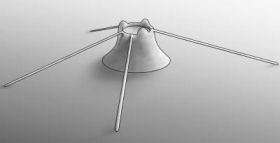12 March 2012
First animal with a skeleton discovered
by Will Parker
 Up until the Cambrian Period, it was understood that animals were soft bodied and had no hard parts, but paleontologists say they have discovered fossil evidence for an organism with individual skeletal body parts that appears before the Cambrian.
Up until the Cambrian Period, it was understood that animals were soft bodied and had no hard parts, but paleontologists say they have discovered fossil evidence for an organism with individual skeletal body parts that appears before the Cambrian.
The researchers, from the University of California, Riverside, made the discovery in Australia. The creature, called Coronacollina acula (artist's impression appears to the right), is between 560 million and 550 million years old, which places it in the Ediacaran period, before the Cambrian explosion of life and diversification of organisms took place . The Ediacaran Period, named after the Ediacara Hills of South Australia, covers the era 630-542 million years ago. The Cambrian Period ranges 542-488 million years ago.
"We now have an organism with individual skeletal body parts that appears before the Cambrian. It is therefore the oldest animal with hard parts, and it has a number of them - they would have been structural supports - essentially holding it up. This is a major innovation for animals," said lead scientist Mary Droser.
Droser said Coronacollina acula is seen in the fossils as a depression measuring a few millimeters to 2 centimeters deep. But because rocks compact over time, the organism could have been bigger - 3 to 5 centimeters tall. Interestingly, it is constructed in the same way that Cambrian sponges were constructed. "It therefore provides a link between the two time intervals," she explained. "We're calling it the 'harbinger of Cambrian constructional morphology,' which is to say it's a precursor of organisms seen in the Cambrian. This is tremendously exciting because it is the first appearance of one of the major novelties of animal evolution."
The appearance of Coronacollina acula signals that the initiation of skeletons was not as sudden in the Cambrian as was thought, and that Ediacaran animals are part of the evolutionary lineage of animals as we know them. "The fate of the earliest Ediacaran animals has been a subject of debate, with many suggesting that they all went extinct just before the Cambrian," Droser said. "Our discovery shows that they did not."
According to Droser's report in Geology, Coronacollina acula lived on the seafloor. Its body was shaped like a thimble to which at least four 20 to 40-centimeter-long needle-like "spicules" were attached. Coronacollina acula most likely held itself up by the spicules, Droser says, adding that it ingested food in the same manner a sponge does and was incapable of locomotion. How it reproduced remains a mystery.
"We often associate skeletons with predation since skeletons greatly assist animals in their fight against predators," Droser said. "But Coronacollina acula used its skeleton only for support, there being no predators in the Ediacaran."
Related:
Discuss this article in our forum
Cambrian explosion linked to rapid super-continent shift
Artistic mega-octopus may topple ichthyosaur from top of Triassic food chain
Scientists identify possible smoking-gun for multicellular life
Source: University of California - Riverside
